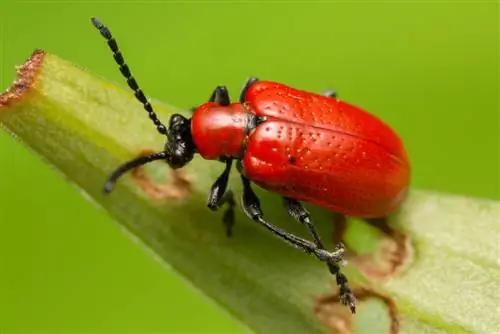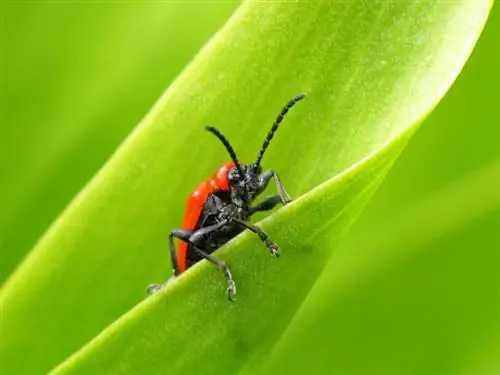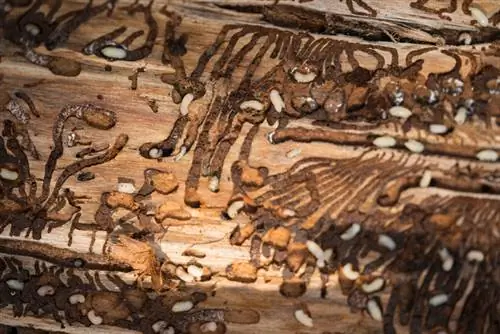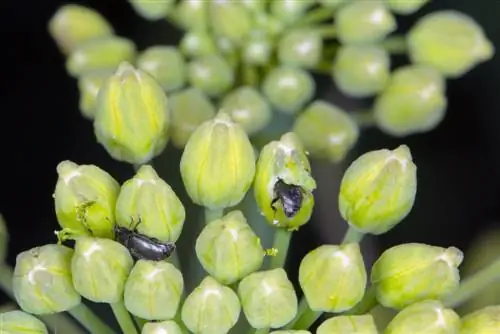- Author admin [email protected].
- Public 2023-12-16 16:46.
- Last modified 2025-06-01 06:02.
When magnificent lilies lose their courage to live under the burden of pests, the lily hen is usually behind it. Read this guide on how to accurately identify beetles and larvae. Explore the best natural control methods against lily beetles in tried-and-tested instructions.
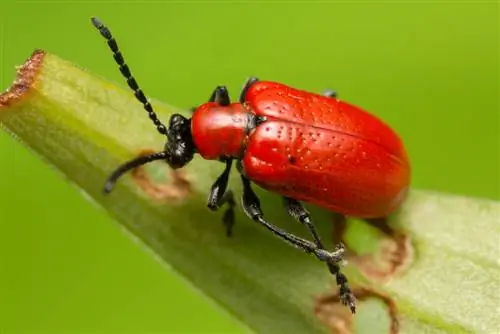
How do I control lily chicken naturally?
To combat lily chickens naturally, you should shower the infected plants, shake them off or use biological sprays such as soap-spirit solution or tansy decoction. You can also use rock dust or algae lime as organic powder.
- Lily Hen is a bright red beetle with a 6-9 mm large, slender body, 2 long antennae, 6 black legs and agile flight ability.
- A lily larva is orange-red, 4-8 mm long and covered in a brownish feces sac.
- Biological control agents are: showering, collecting, soap-spirit spray, tansy decoction, rock dust and algae lime.
Identifying lily chickens - profile and lifestyle
If a bright red beetle crawls around on lilies, alarm bells ring for hobby gardeners. The lily hen has arrived with an insatiable appetite for lilies of all kinds, imperial crowns, checkerboard flowers, lilies of the valley and even chives. The following profile explains how you can recognize lily beetles and larvae with facts about their appearance and lifestyle:
| Lily Chicken | Larva | |
|---|---|---|
| Size | 6-9mm | 4-8mm |
| Color on top | signalrot | orange-red to yellowish-brown (without poop bag) |
| Color underneath | black | orange-red to yellowish-brown (without poop bag) |
| Legs | 6 black legs | 6 stubby legs at the front |
| Able to fly? | yes | no |
| Activity start | from April | 6 days after egg laying |
| Number of generations | 2 to 3 | |
| Botanical name | Lilioceris lilii |
Have the compact facts aroused your interest in further information? Then please read on. The following sections shed more light on the appearance and fatal lifestyle of lily chickens:
Appearance beetle and larva
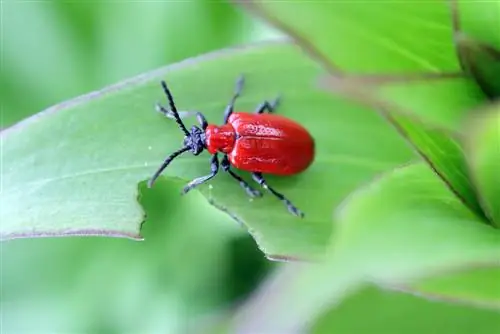
The red wings are trademarks of the lily chick
Trademarks of lily chicks are sealing wax red, rounded wing coverts, epically long antennae and a slender body. The shiny elytra have tiny pits and border a bright scarlet pronotum. As a color contrast, the head, antennae, underside and legs are pitch black. Upon closer inspection, it can be seen that the long antennae are made up of eleven segments.
The orange-red body of a lily larva is hidden under a brown covering of feces. Only the head sticks out of the poop bag. In this way, the larvae are excellently protected against predators and the blazing sun, so that they can constantly feed on leaves, shoots and buds. The beetle larvae produce the fecal screen themselves. For this purpose, the anus is moved towards the back.
Lifestyle
At the beginning of April, lily chickens crawl out of their winter quarters in the ground. Starved, the beetles dedicate themselves to extensive regeneration feeding for a few weeks in order to gather strength for the upcoming mating season. As if the pests were aware of their signal color, they like to hide under the leaves or in dark leaf axils. When danger threatens, lily beetles fall backwards to the ground to hide their bright red wings.
Reproduction
Female lily beetles lay a total of 350 eggs two weeks after mating. The female beetles place the 1 mm small, orange-red eggs in packets with an average of 12 eggs on the undersides of the leaves along the midribs. Within 6 days, the larvae hatch, wrap themselves in their excrement sack and start a feeding spree on the host plant. After two to three weeks, the fully-fed larvae drop down along with their padded shell to pupate in the ground. The metamorphosis into the finished lily beetle is completed after two weeks and the vicious circle begins again. In this way, lilycocks produce up to three generations per year between April and September. The image below illustrates the cycle of ruin on an imperial crown:

malicious image
Because lily hens can hide well and merge backwards into the ground when threatened, feeding damage is often the only indication of the presence of the pests in the flower bed. Pitting in the leaves and bulging buds that do not open but rot are the first indications. If you lift suspicious plant leaves, you will see orange-red egg packets or larvae in their brownish feces.
Excursus
Chicken with six legs
The lily cockerel owes its name to a chirping sound that is reminiscent of roosters crowing. The sound is produced using cross-striped chitin strips on the abdomen, which lily beetles rub against the elytra through up-and-down movements. Experts interpret the unusual “musical instrument” as a defensive weapon against enemies and an aid to communication with other species.
Fight lily chicken naturally

Lily chickens should be controlled promptly before they cause major damage
In the natural garden, poison and chemical agents are not allowed to combat lily chickens. Anyone who is familiar with their sophisticated, sophisticated way of life can treat lily beetles and their brood with home remedies. The following table lists biological control methods that destroy beetles, larvae and eggs:
| Manual methods | Biological sprays | Organic powder |
|---|---|---|
| Shower off | Soap-spirit solution | Rock flour |
| Shake it off | tansy decoction | Algae limestone |
The following instructions explain the correct use of these home remedies against lily chickens in detail. How to destroy voracious lily beetles, larvae and eggs without using chemicals:
Shower off
A strong shower has proven to be a natural remedy against lily chickens. If you spray infected plants with as strong a jet of water as possible, you will particularly catch the voracious larvae, which fall to the ground along with the sticky excrement bag. With their short, stubby legs, the beasts cannot find their way back to the food plant and starve.
After the shower, check the underside of the leaves again. If stubborn egg packets are visible at this point, tear off the sheet or wipe the eggs with a kitchen paper towel.
Shake it off
Early risers among hobby gardeners have the best chance of killing numerous adult lily beetles that are able to fly. In the early morning hours you can shake off the cold-hardened pests from the plant leaves. Beforehand, spread out a close-meshed net or a worn-out curtain on the floor. Lily hens always fall on their backs. If the black underside points towards the sky, the pests are difficult to spot with the naked eye.
Soap-spirit solution
With a biological spray you can get rid of beetles and larvae in one fell swoop. You already have the ingredients for the following home remedy in your pantry. How to do it right:
- Heat 1 liter of water in a kettle
- Dissolve 1 tablespoon of pure curd soap in warm water (do not let it boil)
- Stir in 15-20 ml of spirit or ethanol
- Let the solution cool and pour into a spray bottle
Spray plants infected with chicken lily on the underside and upper side of the leaves, including the shoots and leaf axils. Repeat the application every 3 to 4 days until no more pests are seen.
Important note: Recipes for biological sprays are circulating online with the fatal dosage of 200 ml of alcohol, 1 tablespoon of soap and 1 liter of water. With this high-proof brew you can reliably destroy lilies AND lilies in one fell swoop.
tansy decoction

Rainfarn decoction is a great home remedy for lily chickens
In organic gardens, tansy decoction is said to be highly effective against lily beetles. The wild herb can be recognized by its yellow basket flowers from June to September and has the apt second name vermin herb. Tansy proves its effectiveness against lily chickens as a decoction. This is how it works:
- Collect 30-40 grams of herbs and flowers
- Pour 1 liter of water in a kettle
- Bring to the boil and simmer gently for 20 to 30 minutes (please stir occasionally)
- Remove the mixture from the heat and let it steep for 24 hours
Sift out the plant residue and fill the tansy broth into a spray bottle. Mist infected lilies, imperial crowns or chives repeatedly until there are no more beetles or larvae to be seen. As an extra tip, we recommend drying part of the tansy harvest so that next spring you are prepared against another attack by cunning lily hens that have overwintered in the garden soil.
Organic powder
If a wafer-thin layer of algal lime or rock dust covers endangered plants, lily beetles turn away as soon as they approach. Existing lily larvae lose their appetite when the fine-grained powder crunches between their teeth. Regularly pollinate the pests' potential food plants on the top and bottom of the leaves down to each dark leaf axil. This can be done excellently with a powder syringe. To ensure that the organic powder sticks to the underside of the leaves, fill algae lime or rock dust into a nylon stocking (€7.00 on Amazon) and tap the plant tissue.
The following video presents useful tips and tricks for natural control of lily chickens in the garden:

Predators versus lily-cockaders
In the natural garden, the consistent avoidance of pesticides is rewarded with a diverse group of hard-working beneficial insects. Green dry stone walls, flowering wild fruit hedges and hospitable nesting boxes invite numerous predators of the lily beetles. Where these natural enemies feel at home, insatiable lilies and larvae have a bad hand:
- Hedgehog
- Parasitic wasps
- Predatory Beetle
- Spiders
- Shrews
- Birds
With this large array of busy beneficial insects in the garden, most pests have little chance of becoming a nuisance.
Tip
If lilies have the right plant neighbors at their side, voracious lily chickens will give their favorite food plants a wide berth. Picturesque basil varieties or aromatic rosemary are useful as floral bodyguards, whose intense scent effectively repels lily beetles.
Preventing lily chickens - tips & tricks
Insatiable lily hens don't just fall from the sky, they crawl out of the ground. Effective prevention methods are based on this behavior. How to stop a lily beetle infestation with natural remedies:
Digging

Digging in spring is the end of overwintering lily chickens
As soon as the garden soil has thawed in spring, dig the soil two spades deep. This opportunity not only prepares the soil perfectly for the coming planting season. At the same time, you destroy a large proportion of the lily beetles that overwinter in the ground.
Netting
Cover the soil with a close-meshed net. In this way you prevent the appearance of lily chickens crawling out of the ground and looking for food plants. Because the netted garden soil is not a feast for the eyes, spread a thin layer of bark mulch or pine bark on the protective net. All types of lilies love it when there is a layer of mulch at their feet.
Clear away autumn clippings
After pruning the perennials in autumn, please do not leave any clippings lying in the bed. The dead leaves are a welcome hiding place and winter quarters for lilies and numerous other pests.
Sprinkle coffee grounds
Lily plants want a slightly acidic soil with a pH value of less than 6.5. From the end of March/beginning of April, regularly sprinkle thin dried coffee grounds on the root disc to keep the soil acidity level. A confrontation with coffee does not end well for lily chickens leaving their winter quarters or pupa house in the ground. Even the smallest amounts of caffeine are toxic to pests.
Curious lily chickens: Not everything that crows in the garden is a rooster.
Frequently asked questions
We discovered lily chickens in the house. What to do?
Lilies or imperial crowns are popular, long-lasting cut flowers for the home. It is not uncommon for a magnificent bouquet of flowers to have several bright red lily hens in its luggage as stowaways. Quarantine infested plants and flowers immediately by isolating the pest victims from other houseplants. Collect or shower the red beetles. Then dust the top and bottom sides of the leaves with rock dust or algae lime. Alternatively, use the soap-spirit solution or tansy decoction recommended in this guide as a biological spray.
Are lily chickens poisonous?
No, lily chickens are not poisonous. However, the voracious larvae cover themselves in a shell made of feces. This is not only disgusting, but also unhygienic. For this reason, we recommend spraying infected plants with as strong a jet of water as possible. Dropped larvae can no longer find their way back to the host plant and die. You can collect isolated red beetles by hand without hesitation.
I don't like touching lily beetles when collecting them. What can I do?
Take an old newspaper and twist it into a funnel. Go to the affected plants early in the morning with an old container. Slide the funnel under a cold-stiffened red beetle. The lily beetle slides into the collecting container as if on a slide.
How can you prevent lily chicken infestation?
Lily chickens usually overwinter as beetles or pupae deep in the ground or under plant leaves. By digging the bed two spades deep in early spring, you can catch the pests while they are still in their winter quarters. If you net the bed soil, beetles crawling out of the ground will not reach their host plants. A thin layer of bark mulch or pine bark makes the unsightly protective net invisible. We also recommend disposing of plant residues in the compost after autumn pruning and not leaving them as mulch.
Tip
Nature-oriented gardeners warmly welcome bright red beetles with spots into their green kingdom. These are useful ladybirds whose larvae happily eat large quantities of aphids. Unfortunately, ladybugs sometimes do not display any spots and become innocent victims of confusion with lily hens. However, lily beetles are significantly slimmer than spherical, round ladybirds.

